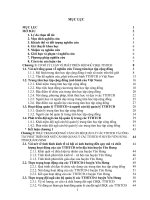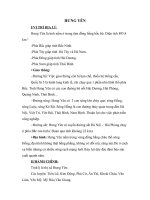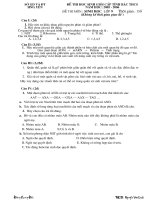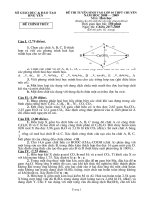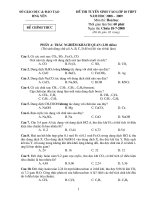The Effects of Total Quality Management on Business Performance: Evidence from Taiwan Information-Related Industries
Bạn đang xem bản rút gọn của tài liệu. Xem và tải ngay bản đầy đủ của tài liệu tại đây (141.46 KB, 37 trang )
The Effects of Total Quality Management on Business Performance:
Evidence from Taiwan Information-Related Industries
Chin S. Oua, Fang C. Liua, Yu C. Hunga, David C. Yenb
a
Department of Accounting and Information Technology
National Chung Cheng University
ChiaYi, Taiwan, ROC
b
Department of Decision Sciences and Management Information Systems
Miami University
Oxford, Ohio 45056
[Point of Contact]
Fang C. Liu
Department of Accounting & Information Technology
National Chung Cheng University
168, University Rd., Min-Hsiung, Chia-Yi, Taiwan 621
886-5-2720411 ext.34506
The Effects of Total Quality Management on Business Performance:
Evidence from Taiwan Information-Related Industries
ABSTRACT
Total quality management (TQM) has been proposed to improve business
performance and received considerable attention in recent researches. This study
empirically examines the extent to which TQM and business performance are
correlated and how TQM impacts various levels of business performance. In this
study, a TQM framework is developed according to a comprehensive literature review.
This framework demonstrates the relationship between TQM and business
performance through examining the direct and indirect effects of seven TQM
constructs on three different levels of business performance. The proposed model and
hypotheses were tested by using data collected from information-related small- and
medium- size enterprises in Taiwan. The results of this aforementioned model support
the proposed hypotheses. The implications of research findings for researchers and
practitioners are discussed and the suggestions for further studies were also provided.
Key Words and Phrases: Total quality management (TQM), Business performance,
Information-related industries
1
The Effects of Total Quality Management on Business Performance:
Evidence from Taiwan Information-Related Industries
Introduction
In such a competitive environment resulted from world globalization and
liberalization, firms survive with much difficulty unless they create the competitive
advantage over their competitors (Adam et al., 2001; Samson & Terziovski, 1999;
Terziovski & Samson, 1999). With the increasing competitive, business survival
pressure and the dynamic, changing customer-oriented environment, total quality
management (TQM) has been recognized as one of the important issues and generated
a substantial amount of interest among managers and researchers (Ahire et al., 1995;
Benson et al., 1991; Flynn et al., 1995; Powell, 1995; Samson & Terziovski, 1999;
Sousa and Voss, 2002; Terziovski & Samson, 1999). Since 1980s, TQM has been
regarded as one of effective ways for firms to improve their competitive advantage
(Kuei et al., 2001). Leading pioneers in the quality area, such as Deming (1986) and
Juran (1993), asserted that competitive advantage can be gained by providing quality
products or services. Additionally, Eng and Yusof (2003) argued that quality holds the
key competitiveness in today’s global market. In addition, TQM has widely
considered as an effective management tool to provide business with stability, growth,
and prosperity (Issac et al., 2004).
2
The benefits of quality improvement can not only be reflected on decreasing costs,
but also on maximizing business profits. In terms of quality improvement, what really
counts for a firm is not just cost minimization, but the effect of superior quality has on
maximizing profits (Freiesleben, 2005). Thus, the study of the relationship between
quality management and firm performance is critical for firms and researchers to
better understand the effects of quality management onto different levels of firm
performance.
In order to accomplish the requirement of quality, firms have to spend time and
effort on the implementation of TQM. To this end, firms will introduce quality
management practice by communicating TQM philosophy and/or principle effectively.
In addition, the application of TQM can be implemented to enhance the relationship
between firms and their suppliers. Moreover, the implementation of TQM can also
increase customer satisfaction by providing preeminent products or services.
According to the CEO’s view of quality which is displayed on Intel’s website, quality
is actually one of Intel’s six important company values. In other words, Intel strives
for pursuing world-class quality through the adoption and/or implementation of its
quality systems. By doing so, Intel dedicates to maintain the highest standards and
ship product that meet the stated goals of Intel (Otellini, 2006).
According to prior researches (Alkhafaji et al., 1998; Mandal et al., 1999), TQM
3
philosophy can be applied to any organizations, including manufacturing, services,
and
information-related
industries.
The
mature
development
of
Taiwan
information-related industries has made it possible for a stabilized global economy
(Einhom et al., 2005). In order to make Taiwan information-related industries more
prosperous and competitive, it proves to be worthwhile to investigate how TQM may
affect business performance. From the discussion above, this study attempts to
examine the relationship between TQM practices and various levels of business
performance and with a special focus on information-related industries in Taiwan. The
objective of this study is to provide empirical evidences on whether or not
implementation of TQM practices affects various levels of firm performance. The
contribution of this study is to propose a model which can study TQM effects more
effectively and hence, implement TQM in a more efficient manner. The findings
obtained from this study can be useful for researchers and practitioners in the quality
management area.
Literature Review
The Effects of TQM on Business Performance
The benefits of an effective TQM implementation can be studied with three different
perspectives. Firstly, from the operating angel, the reason that TQM has became a hot
topic in both industry and academia is that it can be applied to improve/enhance
4
global competitiveness (Flynn et al., 1995; Samson and Terziovski, 1999). Firms with
effective TQM implementation can accomplish the internal benefits such as
improving quality, enhancing productivity enhancement, or realizing better operating
income (Corbett et al., 2005; Hendricks and Singhal, 1997). Secondly, from the
financial performance perspective, careful design and implementation of consistent
and documented quality management systems can contribute significantly to superior
financial performance (Corbett et al., 2005). Further, firm with an effective TQM
implementation can significantly outperform on the stock price performance
(Hendricks and Singhal, 2001). Finally, from the knowledge management (KM)
viewpoint, the implementation of TQM can also increase and enhance organizational
knowledge, which in turn helps more understanding of how quality management
practices can affect firm performance (Linderman et al., 2004). Compared with TQM
and KM, there are many similarities between these two management philosophies. If
properly planned, they can complement one another effectively (Hsu & Shen, 2005)
Recent studies have examined the relationship between total quality management
and various levels of business performance (Das et al., 2000; Kaynak, 2003;
Mohrman et al., 1995). Although many results of prior studies supported the positive
effects of TQM on organizational performance (Hendricks & Singhal, 1997; Kaynak,
2003; Madu et al., 1995; Sun, 2000; Terziovski & Samson, 1999), there were several
5
researches which found the implementation of TQM might lead to ineffectiveness of
firm performance (Choi & Eboch, 1998; Dale et al., 1998; Lemak et al., 1997; Reed
et al., 1996). Kaynak (2003) indicated the reasons that the results of these
aforementioned studies have different outcomes probably resulted from the nature of
the research designs such as using TQM practices or business performance as a single
construct. In this study, the authors examine the relationship between seven important
TQM constructs and various levels of firm performance and measure how each TQM
constructs affects other TQM constructs.
Hypotheses Development
Base on the result of literature review, this study concluded seven factors to be the key
driving force to an effective implementation of TQM. Namely, these seven factors
include: customer focus, management leadership, human resource, quality data &
reporting, suppliers’ management, design management, and process management
(Ahire et al., 1995; Flynn et al., 1994; Kaynak, 2003; Samson & Terziovski, 1999;
Sousa & Voss, 2002). Further discussions about the aforementioned seven factors are
provided below.
1. Customer focus
For business enterprises, the significant driving force to establish the quality goals
basically originates from customer needs. Generally speaking, customer needs
6
identify the operational goals for firms to meet. And this type of quality goals is also
referred as market-driven (Juran, 1992). Oakland (2005) mentioned that quality
started with the understanding of customer needs and ended when those needs were
satisfied. In order to meet the requirement of customers, top management should
clarify the expectations of its customers. Further, organizational strategy should also
be developed based on customers’ needs. Samson & Terziovski (1999) pointed out
that customer focus is the underpinning principles for firms to implement TQM
programs. Since senior management may have the influence and authority to
dominate the entire TQM implementation, dedicated commitment from top
management about implementing TQM is certainly a necessity. Therefore, this study
proposes that customer focus is positively related to management leadership.
H1: Customer focus is positively related to Management Leadership
2. Management leadership
Management leadership is considered to be another major driver of TQM and it has a
significant influence on determining whether or not a TQM program can be
implemented effectively (Soltani, 2005). Management leadership in fact, refers to
how management level guides and supervises personnel of a firm in an appropriate
manner. Management level provides the necessary resources for training employees to
meet the new requirements and/or changes that are resulted from TQM
7
implementation, and consequently, creates a work environment which is conductive to
employee involvement in the process of changes (Kaynak, 2003; Wilson & Collier,
2000). In addition, effective management leadership is critical to influence the
decision of selecting qualified suppliers and certifying suppliers for quality material
(Flynn et al., 1995; Trent & Monczka, 1999). Management level is also responsible
for mentoring product design and considering market demands & consumer needs
(Deming, 1986; Flynn et al., 1995). In other words, the focus of management is
essential for firms to produce goods that are manufacturable and meet the needs of
customers (Flynn et al., 1995; Juran, 1981). In conclusion, management level plays a
significant role on conducting organizational operation and also highly influences the
decision-making and resource allocation processes for supplier management and
design management, respectively. Therefore, the authors propose that management
level has positive effects on human resource, suppliers’ management, and design
management.
H2a: Management Leadership is positively related to Human Resource
H2b: Management Leadership is positively related to Suppliers’ Management
H2c: Management Leadership is positively related to Design Management
8
3. Human resource
In terms of quality management, employees must be able to measure and utilize
quality data efficiently and effectively (Ahire & Dreyfus, 2000; Ho et al., 1999). The
study of Ho et al. (2001) indicated that human resource, which includes employee
training and employee relation, was positively related to quality improvement, which
was mediated through utilizing quality data and reporting. Thus, whether or not a
TQM program will be successfully implemented mainly depends on the collaboration
and coordination among a firm’s workforce. An effective implementation of TQM can
be derived from employees’ understanding of the philosophy and principle of TQM
implementation. Furthermore, if employees have high consciousness of TQM, the
data and reporting of quality control prepared by working staffs will be easy to
uncover the reality and thus, can be used to correct quality flaws or mistakes
immediately and effectively. In this way, the authors propose that better human
management will result in more positive effect on producing quality data and
reporting.
H3:
Human Resource Management is positively related to Quality Data &
Reporting
4. Quality data & reporting
Quality data and reporting utilize quality reports and control charts to identify explicit
& potential quality problems and provide timely information for correcting &
9
improving problems explored (Ho et al., 1999). In other words, a good data and
reporting system can timely and correctly reflect the actual circumstance/situation to
management level. It can also provide management level adequate information to
make timely decisions. With regard to quality data and reporting, it can help
management or employee to identify and solve problems stemming from input
materials that are supplied by cooperative suppliers (Adebanjo & Kehoe, 1999). In
addition, several studies indicated that the goals for firms to implement TQM were
mainly focused on building quality into the products rather than merely inspecting
quality into the finished products or removing defective products (Flynn et al., 1995;
Handfield et al., 1999; Tan, 2001). Since effective design management requires
various resources to support, such as considering the requirements of customers or
coordination of procurement function, design function, production function & supply
function, design management can be effectively implemented only if quality data and
reporting are collected and shared throughout the organization in a timely manner
(Ahire & Dreyfus, 2000; Easton & Jarrell, 1998; Flynn et al., 1995; Handfield et al.,
1999; Ho et al., 1999). Additionally, quality data and reporting can provide employee
timely information to deal with changes or problems occurred and further examine the
results with the improvements made (Flynn et al., 1995; Handfield et al., 1999; Ho et
al., 1999). Thus, an effective quality data and reporting system will have positive
10
impacts on enforcing suppliers’ management, design management, and process
management aspects (Kaynak, 2003). Therefore, the authors propose that quality data
and reporting is positively related to suppliers’ management, design management, and
process management.
H4a: Quality Data & Reporting is positively related to Suppliers’ Management
H4b: Quality Data & Reporting is positively related to Design Management
H4c: Quality Data & Reporting is positively related to Process Management
5. Suppliers’ management
With regarding to suppliers’ management, an effective suppliers’ management will
enforce the cooperation between suppliers and firms by allowing suppliers’
involvement and/or participation not only in the design process but also in the
production process, and help the procurements of materials or parts meet firm’s
requirements and be efficiently utilized (Flynn et al., 1995; Shin et al., 2000; Tan,
2001). The research findings of Kaynak (2003) showed that suppliers’ management,
which emerged as an important component of TQM implementation, had directly
positive effects on both design management and process management. In addition, the
quality of materials provided by suppliers is important and the starting point for firms
to produce quality products. Eventually, a good quality of raw materials will reduce
11
the occurrences of rework, scrap, and/or defective outputs. Ultimately, it can result in
a good operational performance. From the discussion above, suppliers’ management
can be used to streamline the suppliers’ base to facilitate the following tasks such as
managing suppliers’ relationship, developing strategic alliances with suppliers,
cooperating with suppliers to ensure meeting the customers’ expectations, involving
suppliers early in the product development process, and enhancing the process
management (Flynn et al., 1995; Kannan & Tah, 2005). Therefore, the authors
propose that suppliers’ management is positive related to design management, process
management, and operating performance.
H5a: Suppliers’ Management is positively related to Design Management
H5b: Suppliers’ Management is positively related to Process Management
H5c: Suppliers’ Management is positively related to Operating Performance
6. Design management
Effective design management can increase the efficiency of process management and
improve operating efficiency. The study of Ahire & Dreyfus (2000) showed that
design management has positive impacts on process management, internal quality,
and external quality. The empirical results of Kaynak (2003) showed that
product/service
management
had
significantly
12
positive
effects
on
process
management and quality performance, which in turn influenced operating
performance. Thus, the authors hypothesize that design management may have
positive impact on process management and operating efficiency.
H6a: Design Management is positively related to Process Management
H6b: Design Management is positively related to Operating Performance
7. Process management
Inferior quality manufacturing process will result in higher scrap rate and rework rate
which will lead to more resource consumed to produce qualified products (Ahire &
Dreyfus, 2000). The goal of process management is to reduce process variation by
building quality into the production process (Flynn et al., 1995; Handfield et al.,
1999). The effects of reducing process variation will increase the quality of outputs as
well as decreasing the occurrences of unnecessary costs such as rework costs and
waste costs by finding and correcting quality problems immediately (Ahire & Dreyfus,
2000; Anderson et al., 1994; Forza & Flippini, 1998). Thus, the effectiveness of
process management implementation has been cited as one of the major dimensions of
integrated quality efforts (Anderson et al., 1995). As a result, the authors can draw the
following hypothesis:
H7: Process Management is positively related to Operating Performance
13
8. Firm’s performance
There are plentiful studies investigated the relationship between TQM and firm
performance. Kaynak (2003) indicated that quality improvement had positive effects
on improving a firm’s financial and market performance. However, as the effects of
TQM have different impacts on internal quality and external quality, TQM
implementation that directly and positively improves firm’s operating performance by
increasing quality performance (Kaynak, 2003), has indirect effects on increasing
customer satisfaction as well as market share (Handfield et al., 1998; Hendricks &
Singhal, 1997). It is further noted that quality management can improve operating
efficiency by reducing defect rate, scrap rate, and the occurrence of rework. The
improvement of operating efficiency will improve customers’ satisfaction and
eventually the company’s financial performance. In addition, the improvement of
customers’ satisfaction and loyalty may sustain or enlarge market share, which can be
eventually transformed into better firm’s financial performance (Ahire & Dreyfus,
2000; Choi & Eboch, 1998). Thus, the authors propose that operating performance
resulting from TQM implementation will increase customers’ satisfaction and
improve financial performance, respectively. In the meantime, the improvement of
customers’ satisfaction will also have positive effect on improving financial
performance. So, hypothesis H8 is proposed below.
14
H8a: Operating Performance is positively related to Customers’ Satisfaction
H8b: Operating Performance is positively related to Financial Performance
H8c: Customers’ Satisfaction is positively related to Financial Performance
Based on discussion above, this manuscript establishes the research model, which
examines the relationship among seven TQM constructs and various levels of firm
performance, to measure the direct and indirect effects of TQM on firm performance.
Figure 1 illustrates this research model and Table 1 tabulates the hypotheses that this
study proposed and clarified the relationship between TQM and firm performance.
-------------------------------------------------------------------------------------------Insert Figure 1 and Table 1 around here
--------------------------------------------------------------------------------------------
Research Methodology
Development of the survey instrument
This study hypothesizes that firms with TQM practices should have better effects on
various levels of firm performance. In order to examine the relationship between
quality management and business performance, this study takes small- and mediumsize enterprises from the information-related industries in Taiwan to be the sampling
target to investigate the effects of TQM implementation. A total of seven constructs
which are considered to be important for effective TQM implementation are proposed
15
to form a questionnaire. The questionnaire developed in this study consisted of three
main sections, including the background of the company, the motivation and
implementation situation of TQM practices, and specific questions designed to
investigate TQM constructs developed from the proposed research model. A
five-point Likert scale was employed with a score of 1 indicating “strongly disagree”
and 5 representing “strongly agree” to represent different attitude of respondents. The
questionnaire was pre-tested by two professionals in practice. According to the
opinions of professionals, several questions were rewritten consequently.
The sample
A total 600 information-related companies were randomly selected from Information
Service Industry Association of R.O.C. and Taiwan Electrical & Electronic
Manufacturers Association. The survey, through the mailed questionnaire, was carried
out within one and half months in late 2005. Although the response rate was initially
not encouraging, the authors used several techniques to improve the response rate.
These techniques include providing a stamped self-addressed envelope and promising
to mail finial results for sampling companies’ future reference. As a result, 96
questionnaires were finally received and the final response rate was 16%. After
eliminating incomplete survey, 95 questionnaires were kept with the 15.83% of valid
returned rate.
16
Findings and Discussion
This study first applies the descriptive statistics to explore the general profile of the
respondents. Out of 95 valid respondents, 52% were software-related companies and
48% were hardware-related companies. In addition, 67% reported that the existence
of their companies were over 16 years. As to the company size, 30% of respondents
reported that the number of employees was over 200 people. Finally, this study finds
that 40% of respondents have over 76% of products exported.
Secondly, in order to examine the motivation for companies to implement quality
management, this study classified the motivation of quality management into nine
factors and they are: increasing quality of products, improving goodwill, improving
firm’s competitive advantage, the requirement of management, following the trend,
facing the pressure of competitors, and expanding market share. It is worthwhile to
note that the top two strong motivations for companies to implement quality
management are increasing quality of products and improving firm’s competitive
advantage. The possible explanation may be that one of main characteristics of
information-related industries is that, on average, the level of employee’s educational
background is higher than other industries. Because of the better level of educational
background, the employees appreciate the importance of TQM. In addition, the export
ratio of high-tech industry is also higher than other industries. In order to maintain
17
and expand global market share, high-tech industries emphasize much on the
implementation of quality management. In addition, the higher an employee’s
educational background, the more understanding of the meanings of quality
management. Consequently, global market share expansion and higher educational
background provide a continuous momentum to implement TQM.
As for how long a firm has been introduced quality management practices, 33%
respondents have implemented quality management over 16 years. However, 56%
respondents implement quality management by themselves. In order to further
investigate the actual implementations of quality management, the authors investigate
the dollar investment on quality management in 2003 and 2004. The results showed
that, on average, 57% of respondents invested less than NTD $500,000 (USD $16,129)
dollars in implementing quality management activities. For 41% respondents, the
employee number of quality management sector to total employee ratio is less than 5
%. And for the adoption of quality management standard, 51% of respondents chose
to install ISO 2000 version.
The results of descriptive analysis are listed in Table 2. The means and standard
deviations of seven constructs range from 3.69 to 4.11 and from 0.56 to 0.78,
respectively.
18
-------------------------------------------------------------------------------------------Insert Table 2 around here
-------------------------------------------------------------------------------------------Next, this study examines the validity and reliability analysis and the corresponding
results are shown in Table 3. Principal Component and Varimax are used to extract 7
constructs of TQM. The criterion for extracting critical factors is based on whether or
not Eigen value is greater than 1. In addition, the authors use Cronbach’s Alpha to
examine internal consistency which is mainly used to assess the reliability of the
proposed 7 constructs. If the value of Cronbach’s Alpha is greater than 0.6, the
reliability of the responding survey’s results proves to be acceptable.
-------------------------------------------------------------------------------------------Insert Table 3 around here
-------------------------------------------------------------------------------------------Further, this study uses Pearson and Spearman analyses to test the coefficients and
correlations among seven TQM constructs including customer focus, management
leadership, human resource, quality data & reporting, suppliers’ management, design
management, and process management. As shown in Table 4, it can be noted that the
relationships among these seven constructs are all positive to each other.
-------------------------------------------------------------------------------------------Insert Table 4 around here
-------------------------------------------------------------------------------------------After aforementioned reliability and validity analyses, this study employs structural
equation modeling to examine the proposed research hypotheses by using SPSS Amos
19
5.0. The empirical results are illustrated in Figure 2. Figure 2 shows the relationship
among TQM practices and various levels of firm’s performance. The authors divide
the research model into three sections for detailed discussion. The first section is
developed to examine the effects of essential key factors on effective implementation
of TQM philosophy. The authors choose to examine the relationship between
customer focus and management leadership, which is a prerequisite for firms to
implement TQM effectively. The second section is constructed to examine the
relationship among seven TQM constructs and operating performance. Finally, the
third section is used to thoroughly examine the improvement effects of operating
performance (resulted from the implementation of TQM) on customers’ satisfaction
and financial performance, respectively.
-------------------------------------------------------------------------------------------Insert Figure 2 around here
-------------------------------------------------------------------------------------------From the first section, which is shown from the left side of Figure 1, the
relationship between customer focus and management leadership is used to examine
the effect of customer-oriented operating strategy established by management level on
the effectiveness of TQM implementation. The results show that customer focus is
positively related to management leadership since the coefficient is 0.731
significantly at 0.01 significant levels. As the competitive pressure of business
20
environment is increasing, firms must emphasize on improving customers’
satisfaction and expectation to maintain their current market share or strengthen their
competitive edges. To this end, management level will focus on meeting customers’
expectation while considering adequate operating strategy. In addition, the main goal
of TQM implementation is to satisfy customers’ need by providing quality products or
services to them. Therefore, the authors can say that management level should take
customers’ requirements and needs into account when implementing TQM activities.
Next, from the second section of Figure 1, which includes management leadership,
human resource, quality data & reporting, suppliers’ management, design
management, process management, and operating performance, the relationship
among seven TQM constructs and operating performance will be studied. Results
from this study reveal that all the correlation coefficients of management leadership
with respect to human resource management (the coefficient is 0.745 significantly at
0.01 significant levels), suppliers’ management (the coefficient is 0.215 significantly
at 0.1 significant levels), and design management (the coefficient is 0.387
significantly at 0.01 significant levels) are significant. Since resources allocation is
dominated/controlled/influenced by top management level, the commitment of top
management level can significantly influence whether or not TQM activities are
successful. If top management level supports TQM implementation, more resource
21
can be allocated to the rest three external and internal management practices
(customer focus, quality data and reporting, process management). In addition, human
resource management, suppliers’ management, and design management have
significant impacts on whether or not quality management can be effectively
accomplished. Moreover, as human resource management, suppliers’ management,
and design management are all assisted by effective communication and collaboration
processes, management level can, then, make good decision in a real-time manner.
Further, it can be noted that human management has significantly positive effect on
generating quality data and reporting (the coefficient is 0.738 significantly at 0.01
significant levels). The main purpose of human management function is to recruit
high-level talents to complete the assignment effectively. Talents recruited by human
management function can ensure that the goal to provide quality products or service
to customers can be achieved. Additionally quality data and reporting systems are
supported by quality working force. The empirical results from this study show that
the effect of quality data and reporting on suppliers’ management (the coefficient is
0.441 significantly at 0.01 significant levels), design management (the coefficient is
0.571 significantly at 0.01 significant levels), and process management (the
coefficient is 0.564 significantly at 0.01 significant levels) are all significantly
positive. Generating quality data and reporting can ensure the quality of the entire
22
production process ranging from design to manufacture and including inputs provided
by certain suppliers can be monitored and controlled in a timely and appropriate
manner. In other word, a well-designed quality data and reporting can be employed to
control the entire production procedure effectively and further improve quality flaws
in a timely fashion.
As for suppliers’ management, the results of this finding show that the coefficients
of suppliers’ management has a positive relationship to design management (the
coefficient is 0.607 significantly at 0.01 significant levels), process management (the
coefficient is 0.172 significantly at 0.1 significant levels), and operational
performance (the coefficient is 0.382 significantly at 0.01 significant levels). It is also
proved that firm’s competitive advantages come from establishing good cooperation
relationship with qualified suppliers. Suppliers with superior reputation can provide
quality products to meet the requirements set by buyers. Moreover, suppliers having
good collaboration with buyers can also meet buyer’s future needs by attending
buyer’s meetings/conference including product design process and continuous
improvement. As a result, the authors can reasonably conclude that good collaboration
between suppliers and buyers has positive effects for buyers to implement design
management and process management. In addition, the quality of products provided
by good-reputation suppliers can reduce defect ratio or reworks in the production
23
process which will result in increasing firm’s operating performance. However, the
effects of design management and process management on operational performance
are both insignificant (the coefficient is 0.0.116 and 0.210, respectively). The possible
explanation may be that, at present, design management is still not strongly
emphasized by Taiwanese firms in the product development process. Therefore, since
the implementation of design management is ineffective, its effects on improving
process management and operational performance are not significant. With regard to
process management, the coefficient of process management and operational
performance is 0.598 significantly at 0.01 significant levels. The objective of effective
process management is to reduce defects ratio in a cost-efficient manner. Therefore,
superior process management can enhance operating efficiency by controlling quality
aspect in the production process.
Finally, this manuscript examines the effects of improving operating performance,
which are resulted from the implementation of TQM activities, on customers’
satisfaction and financial performance. From the right side of Figure 1, it can be noted
that improvement of operating performance resulting from implementing TQM
effectively is significantly positive associated with customers’ satisfaction (the
coefficient is 0.809 significantly at 0.01 significant levels) and financial performance
(the coefficient is 0.397 significantly at 0.01 significant levels). It is obvious that
24
